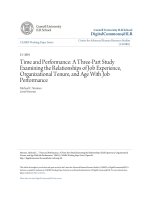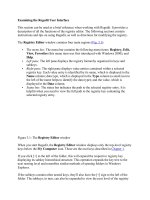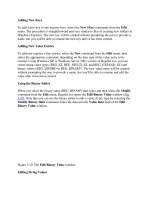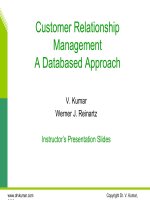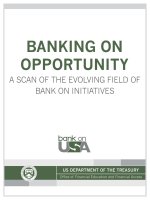Internal Audit 2012*: A study examining the future of internal auditing and the potential decline of a controls-centric approach docx
Bạn đang xem bản rút gọn của tài liệu. Xem và tải ngay bản đầy đủ của tài liệu tại đây (859.31 KB, 68 trang )
Advisory Services
Internal Audit
Advisory Services
Internal Audit
*connectedthinking
Internal Audit 2012*
A study examining the future of
internal auditing and the potential
decline of a controls-centric approachSince 2005, PricewaterhouseCoopers has been conducting an
annual “State of the Profession” survey to provide audit leaders with
important data and insights into current issues affecting the internal
audit community. Given the many forces impacting internal audit in
recent years, we thought it would be beneficial to develop a consensus
projection of the trends likely to shape the world of internal audit by
the year 2012. This report is the result of that effort, and we are deeply
grateful to those who participated.
Observations Table of contents
Overview 1
Internal audit leaders must adopt risk-centric mindsets if they want to remain key
players in assurance and risk management.
Trends
1. Globalization 13
2. Changing internal audit roles 21
3. Changes in risk management 31
4. Talent and organizational issues 37
5. Technological advancement 45
Imperatives for internal audit success 53
Methodology 59
1
Overview
Internal audit leaders must adopt
risk-centric mindsets if they want to
remain key players in assurance and
risk management.
Internal Audit 2012 2
Throughout the next five years, the value of the controls-focused approach that
has dominated internal audit is expected to diminish. As this occurs, internal
audit leaders must redefine the function’s value proposition and adopt risk
centric mindsets if they expect to remain key players in assurance and risk
management. These are the central findings of a major survey and interview project
PricewaterhouseCoopers conducted to develop a composite picture of internal
audit by 2012.
Study results indicate that five identifiable trends—globalization, changes in risk
management, advances in technology, talent and organizational issues, and
changing internal audit roles—will have the greatest impact on internal audit in the
coming years. By understanding these trends and their implications, internal audit
leaders can help senior management identify and manage risk, thereby providing
added value from the internal audit function.
3
A changing risk environment
According to our research, companies now view risk management and internal
controls as fundamental to their business operations. This means that risk and
controls are no longer seen as the technical domains solely of internal audit or other
staff functions. Management as well has begun to take ownership of risk to the
business and of ensuring the effectiveness of the controls designed to mitigate it.
During our study, we observed a range of specific actions to identify, manage, and
control risk. Current trend indicators include improved internal controls and better
controls monitoring. In addition, we noted that companies are now more likely to
assess the merits of a unified approach to governance, risk, and compliance (GRC).
Those testing new methods indicated that they were seeking to achieve better
balance between risk and opportunity; to control risk and compliance cost; and to
enhance planning and forecasting capabilities.
Our research also indicated that globalization and continued advances in
technology have begun to influence how companies think about their traditional
business models and approaches to assurance and risk management. Changing
roles and responsibilities are also influencing corporate efforts to improve risk
management, as are the search for audit talent and more effective organizational
structures for internal audit.
Accelerated rates of change and the faster pace of business contribute to a more
dynamic risk environment, as do increased financial transparency and a 24/7 news
cycle that provides consumers and investors near-instantaneous coverage of risk-
oriented news around the world. The growing complexity of operations in a global
marketplace—including the need to navigate unfamiliar political environments and
work with regulators from multiple countries—makes it difficult for management to
identify and evaluate new risks.
As our survey and interviews indicate, some internal audit functions have begun
to rethink their fundamental value propositions by shifting from an internal audit
model focusing on controls assurance to a risk-centric model where risk and
control assurance are based on the effectiveness of risk management processes
developed by management. For a relative handful of companies, this shift is already
under way, as reflected in Figure 1. For other companies, the shift will occur over
time as corporate risk management frameworks and control processes reach
advanced levels of maturity.
Internal Audit 2012 4
Controls assurance based on
cyclical or routine audit plans
Controls assurance based on
risk-based internal audit plan
Assurance on the effectiveness
of risk management in addition
to controls assurance
The 20th-century
internal audit model
Today’s typical
internal audit model
The risk-centric
internal audit model of tomorrow
Figure 1: The shifting focus of internal audit
5
Internal audit at a crossroads: Choosing a new strategic path
As organizations consider new techniques to manage risks and controls, our study
suggests they will look to both internal audit and other functional areas to assess
risk as well as to perform the more traditional assessments of controls.
Spurred by Sarbanes-Oxley and other reform measures, organizations have taken
steps to strengthen controls and expand their controls-related monitoring activities.
As a consequence, the value ascribed to traditional controls-focused assurance
activities will likely diminish and potentially erode some of the newfound stature
that many internal audit functions have attained in recent years. As other risk
management functions assume new responsibilities in areas such as controls (and,
in the process, enhance their value in the eyes of management), internal audit, with
its strong association with controls assurance, could be perceived as being limited
in its ability to deliver comparable value.
Internal audit thus finds itself at a crossroads, with two possible paths to the future.
One is to continue doing what it does today and nothing more, a path that brings
with it the inherent risk of future obsolescence.
Alternatively, internal audit may choose the path we believe is more likely to lead it
to meet the evolving needs of modern organizations, and the rising expectations of
senior management and audit committees. This path involves moving beyond the
fundamentals of risk and controls to create a new internal audit value proposition.
The new (and inherently more strategic) value proposition would include the
provision of risk management assurance along with the traditional responsibility
of assurance over controls. Adding risk management capabilities would inevitably
help internal audit align itself more closely with an organization’s maturing risk
management functions. But doing so would require something not always
associated with today’s internal audit function: a risk-centric mindset.
Internal Audit 2012 6
A risk-centric mindset means that
internal auditors adopt an all-inclusive,
conceptual approach to audit, risk
assessment, and risk management that
extends well beyond a narrow focus on
controls. With such a mindset, internal
auditors would increase their functional
value at a time when risk assessment
and risk management have become
primary stakeholder concerns.
Based on our survey results and
interviews, we perceive the potential
value of the internal audit function as
being dependent on two key factors:
the nature of internal audit’s primary
focus and the relative maturity of
the risk management processes at
the organization it serves. These
correlations are depicted in Figure 2.
Figure 2: Internal Audit 2012 Value Model
7
Delivering the risk-centric value proposition
As organizations enhance their risk management capabilities, they
progress through four stages of risk management maturity, as
depicted on the horizontal axis of the Internal Audit 2012 Value Model
(Figure 2). The ability of internal audit to provide value stemming
from the delivery of risk assurance depends largely on the maturity
of a company’s risk management organization and structure—the
more mature and developed the structure, the more effective
internal audit can be in delivering a risk-centric value proposition.
Stage 1: Internal control
At the first stage of risk management maturity, management is focused
on providing assurance that selected key internal controls, typically
those in higher-risk areas, are functioning as designed. However, the
organization probably has not embraced a formal internal control
or risk management framework at this stage, and although it has
designed controls, these controls are often not well documented.
When an organization is at Stage 1, its management has yet to
formally conduct and document an enterprise-wide risk assessment.
In fact, its internal audit function may be the only organizational
entity to have developed a comprehensive risk assessment. At this
stage, the testing and monitoring of internal controls is often viewed
primarily as an audit activity as opposed to a management activity.
In addition, controls are largely people-dependent, with little or no
formal training or communication of control activities taking place.
Stage 2: Sarbanes-Oxley compliance
The Sarbanes-Oxley Act of 2002 requires companies to adopt a common
definition of internal control, such as the one promulgated by COSO,
and to formally document their internal control activities. The Act also
provides the impetus for many companies to formalize their approach to
the management, monitoring, and testing of internal controls.
Initially, most companies dedicated significant resources to Sarbanes-
Oxley compliance. This changed over time as organizations streamlined
their compliance processes and improved their abilities to document
and monitor internal control efficiency and effectiveness.
At Stage 2, the focus of internal controls has broadened beyond
that of an audit activity to embrace management ownership
of controls. In addition, some corporate management groups
have begun to develop formal enterprise-wide risk assessments
to strengthen their Sarbanes-Oxley compliance efforts.
Stage 3: Informal risk management
At the third stage of risk management maturity, management
develops its own enterprise-wide risk assessment and seeks to
define ERM for the organization. Management may be setting risk
appetites, developing risk management processes, and reporting
to the board on its risk management activities. The organization
likely has standardized controls, with periodic testing and
reporting of results, and it may be employing automated tools to
support enterprise-wide reporting of risk and control activities.
Stage 4: Functional enterprise-wide risk management
At the final stage of risk management maturity, management defines
and implements formal risk management processes. Management has
adopted a formal definition for ERM, such as the COSO enterprise
risk management framework, and it has conducted a comprehensive,
enterprise-wide risk assessment. Management also sets risk
appetites for the organization, manages and monitors responses to
risk management issues, and provides assurance to the board as to
the effectiveness of the organization’s risk management processes.
A Stage 4 organization might have a chief risk officer. It might
have real-time management and monitoring of risks and control
activities. And it might have automated tools in place to support
control activities and allow the organization to make rapid
changes to those activities in anticipation of emerging risks.
Internal Audit 2012 8
As organizations enhance their risk management activities, they move from left
to right along the horizontal axis of the Internal Audit 2012 Value Model. It is not
known how many organizations will eventually have fully functional enterprise-
wide risk management systems, and will thus attain the highest level of risk
management maturity. However, the results of our survey and interviews indicate
that numerous organizations across a range of industries have begun to strengthen
their enterprise risk management (ERM) capabilities. Risk management discussions
at these organizations frequently involve internal audit leaders as well as audit
committee representation.
In an environment characterized by a heightened focus on risk management, it is
imperative that the risk management initiatives of internal audit functions match
those of management. When they do, internal auditors are able to strengthen
their focus on risk assurance and thus move up the vertical axis of the Internal
Audit 2012 Value Model to demonstrate more value. Some proactive internal audit
groups have already taken the lead in the area of risk, helping senior executives
refine corporate risk practices while ensuring that internal audit’s approach to risk
management is in synch with that of top management.
For internal audit functions, the proactive path to providing greater value requires
that internal audit evolve in a manner that complements the company’s approach
to governance, risk, and compliance oversight. Failure to do so could detract
from the growing levels of respect being accorded internal audit by senior
management and audit committees.
But first, internal audit needs to determine how best to contribute to the
organization’s ability to improve risk management activities. With a risk-centric
mindset, internal audit may be asked to play a leadership role or serve as catalyst
and facilitator, coordinating with members of other risk and control functions to
ensure that organizational risks are appropriately controlled and managed.
Our 2012 research shows that leading chief audit executives (CAEs) increasingly
expect audit committees and senior management groups to pressure internal
audit functions to step up their performance in risk management or face being
absorbed or pushed aside by other, potentially more effective, players in the risk
management discipline. When discussing these possibilities, a number of CAEs
interviewed for this report said they could foresee potential consolidations among
various corporate functions currently performing internal audit, risk and control
management, and compliance activities. How internal audit would fare with such
consolidations is unclear. What is clear is that it must move quickly to change
and redefine its fundamental value proposition in order to remain a strategic
contributor to the organization.
CAE views on strengthening internal
audit’s value proposition
Advice from audit leaders interviewed
for this report:
• Be relevant, not redundant.
• Partner with other risk and control
functions within the company.
• Stay in front of the business rather
than lagging behind it.
• Focus on start-ups and other future-
oriented activities that have relatively few
core controls and thus carry higher risks.
• Focus on new issues and types of audits,
such as post-acquisition reviews.
• Determine what audits to perform to
strengthen corporate objectives; ensure
that management has developed effective
processes for managing risk.
• Use the COSO ERM model to improve the
ability of internal audit to understand and
manage risks.
• Take a flexible approach to the work:
do not be too constrained by the annual
plan; ensure there is flexibility and
sufficient unallocated time to address
developing issues.
If internal audit is to
remain vital and strong,
its fundamental value
proposition must shift.
Internal Audit 2012 12
Our study suggests that the continuing migration toward a more risk-centric
approach to internal audit is driven by five key trends, which are all likely to re-
shape internal audit by 2012:
1. Globalization
2. Changing internal audit roles
3. Changes in risk management
4. Talent and organizational issues
5. Technological advancement
Results of the study reflect an expectation among participants that in the coming
years, globalization, talent, and technology will have a particularly significant
impact on the internal audit profession. Yet all five trends appear to be closely
related: increased globalization and advances in technology will have a direct
impact on talent, and there are notable ties between what participants had to say
about the role of internal audit and the changes they expect to see in organizational
approaches to risk management.
Leading CAEs already have developed strategic platforms to capitalize on
opportunities and manage risks associated with globalization, technological
advancement, and other organizational issues. This report reflects the risk-
centered, future-oriented thinking of these leading CAEs, as well as our
experience and continued study of the profession.
13
1. Globalization
The pursuit of international growth via new or expanded markets and the hunt
for lower-cost suppliers abroad create a unique set of issues for multinationals,
according to our study. Among the most common:
The economies of Brazil, Russia, India, and China (known collectively as BRIC)
are reordering world markets. China and India in particular will be even stronger
economic centers by 2012.
The globalization of securities markets and the internationalization of accounting
standards are forcing companies to rethink a U.S centric approach to business
and accounting. And in the United States, the internationalization of accounting
standards may lead to a change in the language of accounting.
The growth of outsourcing and an upsurge in the offshoring of services and
manufacturing have made global supply chains more interconnected and more
vulnerable and have increased financial market volatility.
Our research identified globalization
1
as a significant and growing trend impacting
internal audit today and in the future. As organizations expand to take advantage
of global markets and supply chains, internal audit faces a burgeoning need for its
services. A majority of survey respondents expect globalization, outsourcing, and
offshoring to have a significant impact on internal audit roles and responsibilities
over the next five years.
Nearly 75 percent expect globalization to have a moderate to very strong impact
on the roles and responsibilities of internal audit, with 43 percent anticipating a
strong or very strong impact and 31 percent projecting a moderate impact.
Seventy-seven percent believe that the wide-scale outsourcing of corporate
or enterprise-wide functions or operations will have a moderate to very strong
impact on internal audit roles and responsibilities. On the topic of outsourcing in
general (which, in the survey, addressed a broad range of services including but
not limited to internal audit), 40 percent of respondents anticipate a strong or
very strong impact, while 37 percent project the impact to be moderate.
Nearly 7 in 10 respondents expect offshoring of corporate or enterprise
functions or operations to have a moderate to very strong impact on internal
audit in the near future, with 37 percent anticipating a strong to very strong
impact and 32 percent projecting a moderate impact.
•
•
•
•
•
•
1
Globalization is an umbrella term that refers to increasing global connectivity, integration,
and interdependence in the economic, social, technological, cultural, political, and ecological
spheres. Outsourcing and offshoring are key elements of globalization that involves cross-border
transactions, the movement of capital, and the integration of financial markets.
Internal Audit 2012 14
When asked where internal audit responsibilities are likely to increase the most
over the next five years, 75 percent of respondents chose auditing of outsourced
or offshored operations, with 15 percent indicating these responsibilities would
increase “much more” and 60 percent saying “somewhat more.” In addition,
39 percent projected likely increases in the number of internal audit resources
devoted to globalization.
On balance, most of the CAEs we interviewed agree that globalization is a
significant trend that will gain further momentum over the next five years. “Taking
advantage of globalization is all about speed and fluidity,” said the audit leader of
a global chemical company. “Offshoring [to relocate business processes] is easier
to do than ever; joint ventures are happening constantly, and change is a constant.
To deal with these challenges, companies must develop governance processes
that are capable of responding to change.”
Experienced global players share concerns
While members of the survey population see internal audit responsibilities expanding
as a result of globalization, CAEs from seasoned global companies pointed out
that risks associated with the pursuit of global markets could be difficult for internal
auditors to identify and assess. “Internal audit is vastly unprepared for the risks of
global expansion,” said a media company CAE. A number of other CAEs added
that inexperienced internal audit groups might lack the insight needed to adequately
support the global aspirations of their organizations.
Audit leaders interviewed for this report also expressed concern about a range
of other topics, including the following:
They expect compliance demands to grow in both amount and complexity,
with one CAE noting that non-U.S. regulators and regulations, in general,
would increase in importance. Compliance with the Foreign Corrupt Practices
Act (FCPA) is a concern, as are political risks and risks to reputation borne by
organizations active in international markets.
Cultural issues ranked as an important topic, evidenced by CAE awareness of
the need to be sensitive to how people think and act in China, India, and other
key trading-partner areas.
•
•
15
The CAE of a global defense and aerospace company that buys parts from
around the world said that vendor quality and standards are of primary concern
to all global companies. She said that when she assesses key risks during the
annual internal audit planning process at her company, she can clearly identify
potential risks in terms of the quality of components and parts for the equipment
manufactured by her company. At the same time, she finds it challenging to
identify and execute the audits needed to determine how effectively such risks
are mitigated.
“The promise of globalization may not be all that great,” said the CAE of a global
systems integrator. Echoing this point, the audit leader of a large global insurance
company believes offshoring and outsourcing could actually decrease if companies
failed to achieve expected returns on investment. The CAE of a financial services
company added that there would be less interest in offshoring when labor costs
were more balanced. “It is the larger organizations that are considering offshoring,”
he stated. “In the short run, there may be cost advantages. But over time,
companies will notice that the cost of labor will equalize.”
•
Internal Audit 2012 16
Organizing global internal audit operations
As companies expand globally, internal audit functions need to determine whether
to provide audit coverage from a central location or from a satellite or branch
operation aligned geographically with the expanded business operations. Survey
respondents generally expect that the internal audit organizational structures for
U.S. companies will remain U.S centric, albeit with a growing global dimension.
When asked to describe the likely predominant structure for internal audit groups
within five years, 54 percent of our study respondents indicated a core internal
audit function based in the organization’s home country, with some of the internal
audit function existing internationally. Another 37 percent expect the predominant
model to be one central internal audit function based in the organization’s home
country. Only a small minority, 8 percent, expects to see most internal audit staff
operating internationally.
Interviewees also provided insights about global staffing and organizational issues,
and about how to approach the auditing process itself when operating outside the
home country. A number of CAEs discussed the importance of maintaining a physical
presence in foreign locations and described how they hire internal audit professionals
abroad to supplement their ranks. For example, the CAE of a global retailer said she
is weighing the pros and cons of establishing a permanent internal audit presence
in China following her company’s acquisition of a major subsidiary in that country.
Another audit leader, the CAE of a leading systems integrator, said his company has
a “hub and spoke” organizational model for its global internal audit operations, with
the corporate hub in North America and spokes in Asia, Australia, Europe, and the
United Kingdom. To improve its ability to do business in China, the company recently
opened an office in Singapore, where the internal audit staff understands English,
GAAP accounting, the nuances of Chinese culture, and the primary language of
China, Mandarin. As the company expands internationally, its internal audit activities
will continue to shift to the “spoke” countries.
The more that companies grow internationally, the more they need to identify and
develop potential leaders, advised the audit leader of a global consumer products
company. “Ideally,” he said, “internal audit will train high-potential employees in key
areas such as business controls, risk management, and IT audit—and then send
them back into the field.”
17
Perspective: Addressing political risk
2
Both our 2012 research and our experience indicate that political risk in global
markets warrants the close attention of internal auditors as well as audit committees
and senior management. At a time when risk-based auditing has become a driving
force within business circles, political risk considerations should be considered
during internal audit risk assessments when the company has global operations.
When it comes to making key decisions about global investments, political
considerations can be just as important as economic ones. Elements that make
emerging markets so attractive—including pent-up demand in a country opening
itself up to foreign trade, investment, and cultural influence—also contribute to
potential economic instability in those markets.
Companies operating abroad in unfamiliar political environments can be exposed
to new types of risks and complexities that threaten business performance and
mask new opportunities. Such risks and complexities range from regulatory and
compliance changes lowering barriers to market entry, to practices that violate
the Foreign Corrupt Practices Act (FCPA). If a company has a presence in foreign
markets, or if it is thinking about making major investments in infrastructure
or operations abroad, it needs timely, accurate, and objective assessments of
the political environment. Economic analysis alone fails to tell the whole story,
particularly in situations where statistical data is either difficult to collect or subject
to manipulation for policy interests. To base global investment decisions solely
on economic data without understanding the political context is risky business.
Given the scope of such challenges, executives of global companies need to
know certain things about political risk: the best ways to assess it, how to factor it
into investment decisions, and how to use the knowledge gained to help improve
global business performance. As companies become more familiar with global
expansion challenges, they are more likely to make political risk a key component
of enterprise-wide risk assessments. They can also be expected to assess political
risk on a more formalized basis.
How can chief audit executives help? They and their internal audit groups
need a solid grasp of how political factors affect corporate governance and
regulatory compliance as well as operating performance and bottom-line
earnings. By monitoring organizational exposures to political risk, internal audit
groups will help strengthen corporate risk management efforts.
2
This material includes excerpts from “Assessing Political Risk,” an article by Richard Chambers
of PricewaterhouseCoopers and Rachel Jacobs of the McGraw-Hill Companies, which appear
in the August 2007 issue of Internal Auditor, published by The Institute of Internal Auditors, Inc.,
www.theiia.org. The excerpts are being used with permission from the IIA.
Internal Audit 2012 18
Political risk management requires a systematic framework to evaluate the
impact of individual risks on stability and to ensure that political risk information is
available when needed to enhance corporate decision-making. Internal audit can
implement a formal program to assess and monitor political risk across business
lines, including procedures to gather, interpret, and evaluate political information
from multiple sources.
If management’s existing enterprise-wide risk assessment includes political
risk, internal audit should consider the impact of this assessment on the internal
audit plan. Conversely, if political risk has not been addressed in management’s
enterprise-wide risk assessment, then internal audit should consider including it
within its own auditing and risk-assessment activities. Some techniques for this
include the following:
In the risk-assessment process, internal auditors should gather objective
information about political risks, factor the information into risk-based audit
planning activities, and communicate findings to the audit committee and
management.
For a company’s new or existing investments or operations, and for sales or
supply chains in international markets, it is wise to monitor rapid economic
growth, instability or deterioration, increasing levels of foreign investment,
and significant changes in governmental leadership.
Potential changes in regulations or trade agreements should also be
addressed, as should any indications of social unrest or other looming
security issues.
Another technique, a process known as political risk analysis (PRA), can
help an organization:
Make better and more timely decisions about international operations,
protect existing global investments, improve business performance,
and exit unstable markets.
Anticipate business-risk implications of political change as well as identify
both opportunities and risks stemming from political shifts and instability.
Improve measurement using risk-adjusted evaluation of
international performance.
Create a comprehensive picture of both the risks and opportunities
associated with global investment decisions.
Take steps to mitigate risks, such as recruiting local partners or limiting R&D
activities in countries where intellectual property is not well protected.
Bottom line: Until political risk analysis is firmly embedded in a company’s
management activities and internal audit can assess the overall effectiveness
of these PRA activities, political risk should be considered during an annual risk
assessment for organizations with global operations.
•
•
•
•
•
•
•
•
19
Perspective: Focusing on the Foreign Corrupt Practices Act
Without question, potential corruption poses serious risks that internal audit and
other corporate watchdog groups need to examine on a proactive, systematic
basis. Although the FCPA was enacted in 1977, there has been a surge in FCPA
enforcement activity against U.S based companies in recent years. Factors behind
this surge include an increase in globalization, elevated whistleblower activity,
growing cooperation among international government regulators in anticorruption,
and a dramatic increase in the scrutiny of emerging markets.
In addition to being subject to the FCPA, U.S. companies are now covered by the
United Nations Convention Against Corruption (UNCAC), the first anticorruption
agreement to be applied on a global level. Parties to UNCAC, including the
United States, agree to criminalize corrupt conduct, to actively deter corruption,
to cooperate internationally on law enforcement, and to take steps to facilitate
international efforts to recover assets. The United States, which approved the UN
measure in late 2006, is actively promoting UNCAC as the cornerstone for regional
multilateral anticorruption activities.
The crackdown on questionable business practices under both the FCPA and the
UNCAC is forcing many companies to implement complex mitigation measures,
to develop more stringent internal guidelines, and to conduct costly investigations
of their foreign operations. At this point, a substantial number of multinational
companies are dealing with one or more allegations of FCPA violations or with
ongoing FCPA investigations. What’s more, it’s not unusual for senior internal audit
staff at major multinational corporations to spend a significant amount of time on
FCPA investigations.
The core challenges faced by management and internal audit alike in assessing
FCPA risks deal with identifying officials who might have received questionable
payments from the company and the routes through which such payments were
made. As previously mentioned, political risk analysis can help auditors develop
roadmaps to link individuals and government-owned companies with a given entity.
Areas of particularly high risk include governmental decision-making regarding
pricing, reimbursements, and contracts with third-party agents. Political analysts
can develop “power maps” to illustrate the linkages between government officials
and private industry as well as the subsidiary relationships through which payments
could be transmitted.
Internal Audit 2012 20
How to strengthen global FCPA compliance: a ten-step plan
1. Evaluate the compliance requirements of the Foreign
Corrupt Practices Act of 1977 and the UN Convention
Against Corruption (UNCAC). Determine their applicability
to your company. For instance, many companies do not
contract with foreign governments and are therefore
outside the scope of the FCPA. At other companies, only
certain subsidiaries deal with foreign governments.
2. Ensure that corporate standards address FCPA compliance
issues and establish minimum thresholds for compliance.
Update corporate documents, policies, and communications
relating to anti-bribery and anticorruption activities, internal
controls, payments to government officials, and other
pertinent subjects. Develop a formal communications
and certification plan covering online access, web-based
training, and messages from senior management.
3. Evaluate corporate policies to ensure that they cover
high-risk activities. Develop a set of global standards
and basic expectations for processes and controls
involving high-risk business activities, specifically
regarding books and records requirements.
4. Provide management training on FCPA compliance.
Promote compliance by educating local management on key
tenets of the FCPA and UNCAC, regulatory communications,
laws and corporate policies dealing with whistleblowers,
and investigative activity by local regulatory agencies.
5. Assess FCPA compliance and document processes and
controls in select/higher-risk subsidiaries. Address the
Leverage Transparency International Corruption Index as well
as anecdotal information. Conduct risk assessment by affiliate,
produce detailed process maps for each high-risk business activity,
and create recommendations for corrective action/remediation.
6. Develop a gl
obal FCPA compliance implementation program.
Develop a formal, standard set of processes and model policies
and procedures to be implemented locally. Create an
implementation “tool kit” with recommended monitoring
controls and internal reporting protocols.
7. Conduct subsidiary pilot programs focused on testing
the execution of the FCPA compliance implementation
program locally. Test and refine Step 6 deliverables.
8. To support global rollout of the FCPA compliance
implementation program, conduct global training on FCPA,
company policies, the FCPA compliance implementation
program, and the implementation tool kit. Conduct webcasts
and selective live meetings designed to train local management
on FCPA, on company expectations for FCPA implementation,
and on the tools necessary to promote implementation.
9. Implement FCPA compliance program globally.
Develop target dates for subsidiary implementation
of the FCPA compliance program.
10. Perform post-implementation validation reviews at select
subsidiaries (focusing on those that did not receive
implementation assistance) to assess management’s
implementation of the FCPA compliance program. Develop
reports on the results of post-implementation reviews for
each subsidiary. Include recommendations for improvement.
Provide for ongoing FCPA compliance monitoring.
